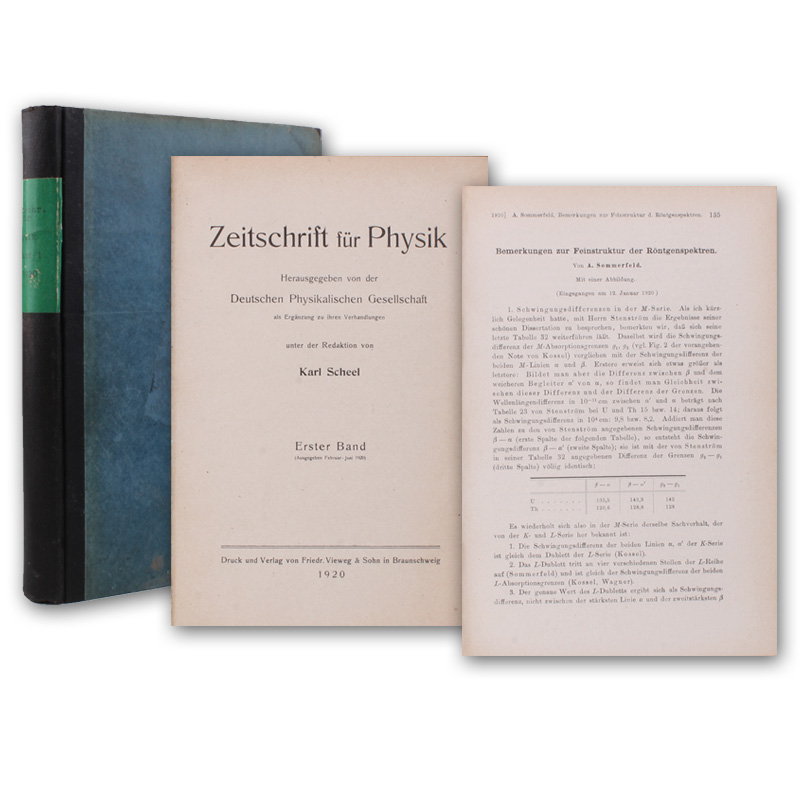114618-01
Bemerkungen zur Feinstruktur der Röntgenspektren. SS. 135-146. In: Zeitschrift für Physik. Band 1.
Braunschweig, Vieweg, 1920. - (23 x 15,5 cm). IV, 474 S. Mit zahlreichen Abbildungen. Halbleinwandband der Zeit.
Erste Ausgabe. - "In these years, 1919-1926, Sommerfeld remained in the forefront of theoretical atomic physics; but he did so by largely reorienting his method and approach... Sommerfeld pioneered a new style of theoretical spectroscopy. In this a posteriori approach, in contrast with the older a priori, the theorist began by immersing himself in the spectroscopic data, and worked back, by means of the combination principle, to the atomic energy levels... Thus where Sommerfeld had previously spoken of 'numerical harmonies' in the quantum theory, he now began to speak of 'number mysteries' (1919) - in the first instance, and most particularly, in the Zeeman effect. An adequate understanding of this phenomenon, and of the complex structure of spectral lines which was intimately connected with it. was then widely regarded as the specific content or contribution of a satisfactory atomic mechanics. Consequently the success of Sommerfeld and life students in the ordering of X-ray, atomic, and molecular spectra was followed with excitement and widely imitated. This approach did not. however, prove to be what it was then widely supposed to be, namely the highroad to quantum mechanics. Still, the results obtained were taken over with but slight alteration into the post-1925 quantum-mechanical theory of atomic structure" (DSB). - Einband leicht fleckig und berieben, sonst gut erhalten. - DSB 12, 525
Bemerkungen zur Feinstruktur der Röntgenspektren. SS. 135-146. In: Zeitschrift für Physik. Band 1.
Braunschweig, Vieweg, 1920. - (23 x 15,5 cm). IV, 474 S. Mit zahlreichen Abbildungen. Halbleinwandband der Zeit.
Erste Ausgabe. - "In these years, 1919-1926, Sommerfeld remained in the forefront of theoretical atomic physics; but he did so by largely reorienting his method and approach... Sommerfeld pioneered a new style of theoretical spectroscopy. In this a posteriori approach, in contrast with the older a priori, the theorist began by immersing himself in the spectroscopic data, and worked back, by means of the combination principle, to the atomic energy levels... Thus where Sommerfeld had previously spoken of 'numerical harmonies' in the quantum theory, he now began to speak of 'number mysteries' (1919) - in the first instance, and most particularly, in the Zeeman effect. An adequate understanding of this phenomenon, and of the complex structure of spectral lines which was intimately connected with it. was then widely regarded as the specific content or contribution of a satisfactory atomic mechanics. Consequently the success of Sommerfeld and life students in the ordering of X-ray, atomic, and molecular spectra was followed with excitement and widely imitated. This approach did not. however, prove to be what it was then widely supposed to be, namely the highroad to quantum mechanics. Still, the results obtained were taken over with but slight alteration into the post-1925 quantum-mechanical theory of atomic structure" (DSB). - Einband leicht fleckig und berieben, sonst gut erhalten. - DSB 12, 525
120 €

